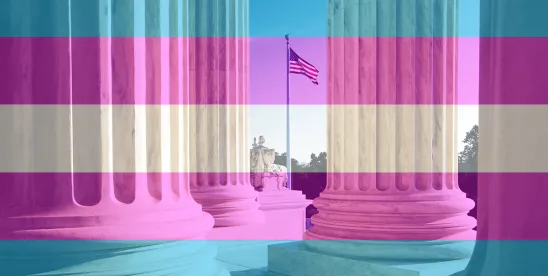On June 18, 2025, the Supreme Court of the United States ruled that a Tennessee law banning gender-affirming care for minors does not classify on the basis of sex in ways that would require heightened scrutiny under the Equal Protection Clause of the Fourteenth Amendment of the U.S. Constitution. In United States v. Skrmetti, a 6-3 opinion written by Chief Justice John Roberts, the Court ruled that Tennessee Senate Bill 1 does not require a higher level of constitutional scrutiny because its prohibitions rely on age and medical diagnosis, but not sex. Instead, the Court found that the Tennessee law met the lower requirements of “rational basis” review, finding that age and medical treatment limitations were permissible uses of state authority.
Quick Hits
- The Supreme Court held that “Tennessee’s law prohibiting certain medical treatments for transgender minors is not subject to heightened scrutiny under the Equal Protection Clause of the Fourteenth Amendment and satisfies rational basis review.”
- The Court reasoned that the state law classifies on the basis of age and medical use—both of which are subject to rational basis review—and not on the basis of transgender status.
- The Court found that the Tennessee law does not classify on the basis of transgender status, “although only transgender individuals seek treatment for gender dysphoria, gender identity disorder, and gender incongruence.”
The Tennessee Law
The Tennessee statute, Senate Bill 1, prohibits all medical treatments intended to allow “a minor to identify with, or live as, a purported identity inconsistent with the minor’s sex” or to treat “purported discomfort or distress from a discordance between the minor’s sex and asserted identity.” Such medical treatments may include surgery, puberty blockers, and hormone therapy. Those treatments are permitted for other medical purposes besides treating gender dysphoria, gender identity disorder, or gender incongruence.
About half the states have similar bans on puberty blockers, hormone therapy and surgeries when used to treat gender dysphoria or similar conditions in minors.
The Supreme Court’s Ruling
“While SB1’s prohibitions reference sex, the Court has never suggested that mere reference to sex is sufficient to trigger heightened scrutiny. And such an approach would be especially inappropriate in the medical context, where some treatments and procedures are uniquely bound up in sex,” Chief Justice Roberts wrote. “Where a law’s classifications are neither covertly nor overtly based on sex, the law does not trigger heightened review unless it was motivated by an invidious discriminatory purpose.”
The Court distinguished this ruling from Bostock v. Clayton County, Georgia, its landmark 2020 ruling finding that Title VII of the Civil Rights Act of 1964 prohibits an employer from firing workers for being gay or transgender. Bostock held that firing an employee for either of those two reasons is discrimination because of sex, because the individual’s sex is a “but-for” cause of differing outcomes. In Skrmetti, the Court found that sex is not a “but-for” cause, arguing that neither a transgender boy nor a transgender girl would have access to the prohibited treatment for gender dysphoria or certain conditions under the law.
In a dissenting opinion, Justice Sonia Sotomayor wrote, “The majority refuses to call a spade a spade. Instead, it obfuscates a sex classification that is plain on the face of this statute, all to avoid the mere possibility that a different court could strike down SB1, or categorical healthcare bans like it. The Court’s willingness to do so here does irrevocable damage to the Equal Protection Clause and invites legislatures to engage in discrimination by hiding blatant sex classifications in plain sight. It also authorizes, without second thought, untold harm to transgender children and the parents and families who love them.”
Timothy J. Stanton is a shareholder in Ogletree Deakins’ Chicago office.
This article was co-authored by Leah J. Shepherd, who is a writer in Ogletree Deakins’ Washington, D.C., office.




 />i
/>i
